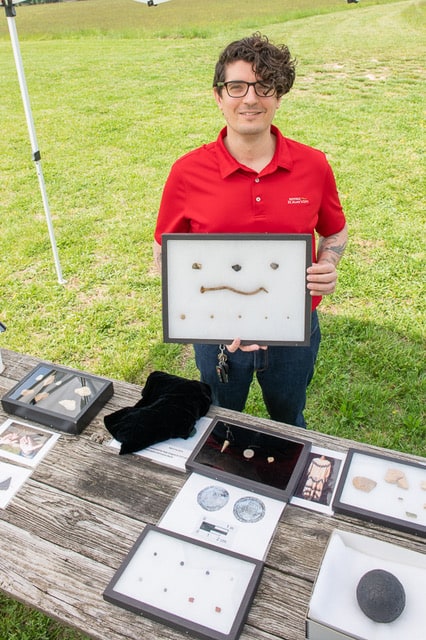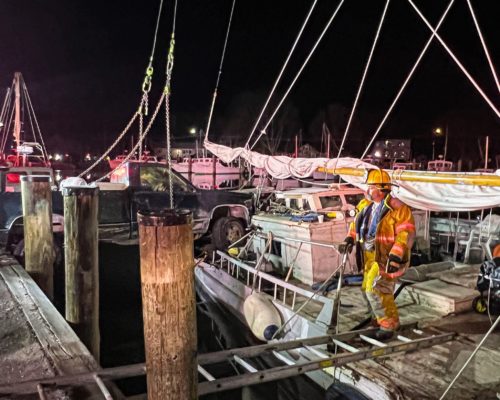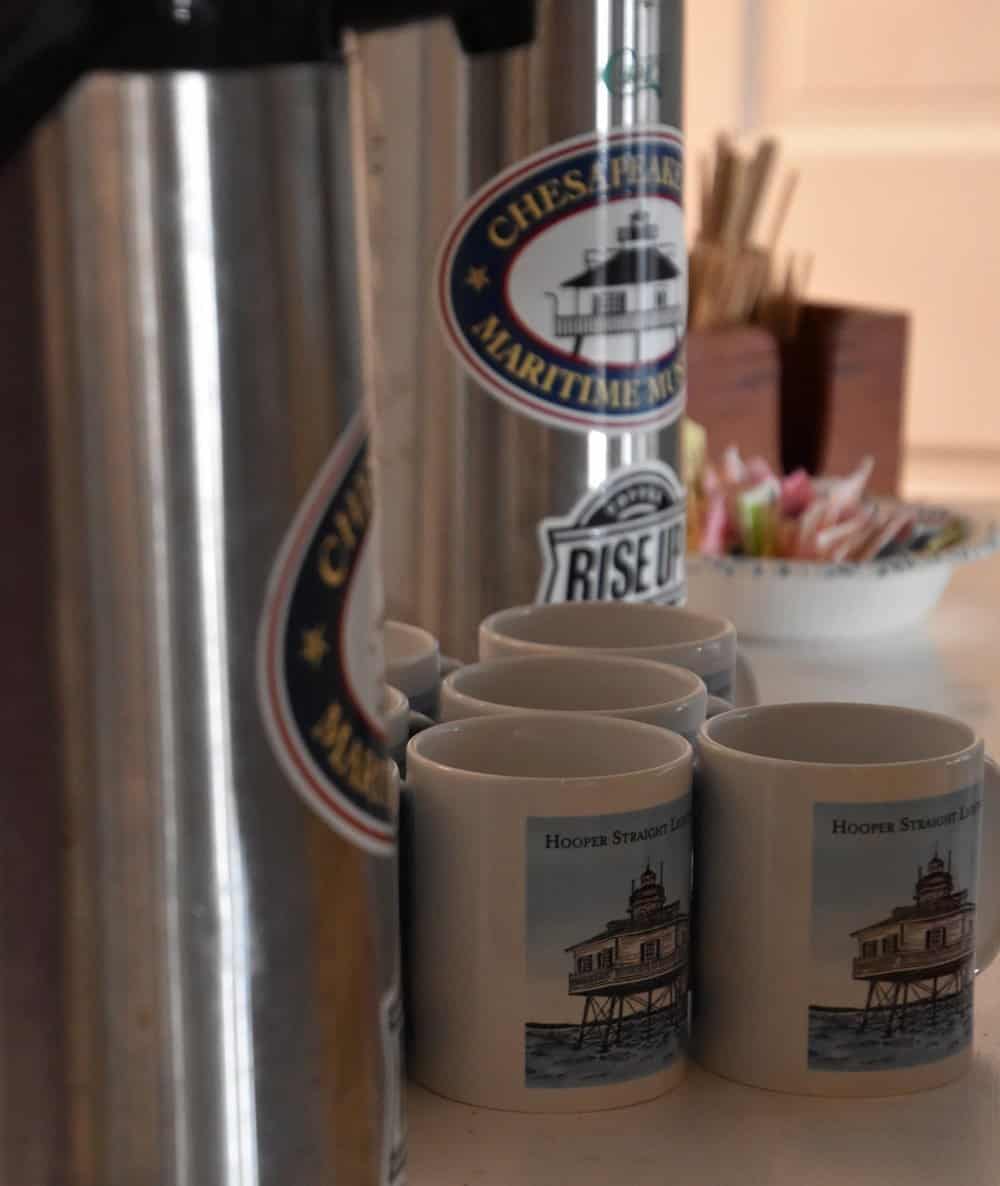by Karen Soule
Don Grata’s weathered hands are surprisingly graceful and testify to more than 35 years of outdoor living on the Rappahannock River. They’re the strong hands of a former beat cop from New York who traded in his firearm for a fishing rod. They’re also the gentle hands of a husband, father and grandfather who moved to the river because “we loved fishing and being on the water.”
But not anymore.
Two years ago, an innocuous looking catfish that his wife, Barbara, would later deep fry to perfection, robbed him of that pleasure and almost took his life. “My neighbor and friend pulled a catfish from his crab pot and asked me if I wanted it,” Don relates, eager to tell his story. “It jumped and the barb stuck my right hand, just a tiny prick. I thought nothing of it.”
Don cleaned that catfish in the gazebo behind his modest riverfront home in Center Cross, Va., about 35 miles from the mouth of the Rappahannock. The next day, Barbara served it for dinner. “That fish got even with me that evening,” says Don. “I felt sick the entire night.”
By morning a red streak had traveled up his arm. Barbara ran outside, corralled two neighbors to help him into the car, and drove him to the local hospital. Within a day, their daughter insisted he go to Richmond’s VCU Medical Center. “When we got off the elevator, a surgeon was standing with a scalpel and a priest was outside the door,” Don recalls.
The doctors told the Gratas that Don had developed a bacterial infection from either eating the catfish or from its barb pricking his skin. The bacteria was Vibrio vulnificus.
Of the various types of Vibrio, the strain that infected Don Grata—Vibrio vulnificus—is the most lethal and is the leading cause of death in the U.S. from eating contaminated seafood. It’s a naturally occurring, free-floating bacterium found in warm salt water virtually all over the world. It is not caused by pollution, and there is no way to eradicate it. It doesn’t change the appearance of infected fish. It just is. Shellfish and other bottom feeders, like catfish and oysters, accumulate these bacteria as they filter water. During the summer months, concentrations of Vibrio multiply as water temperatures climb, just at the same time more and more people are swimming, fishing and boating.
However (and this is a big “however”) Vibrio vulnificus rarely infects human beings. (Dogs can’t develop the infection, so don’t worry about your family pets.) According to the Centers for Disease Control and Prevention (CDC), there are about 500 hospitalizations nationwide for all kinds of Vibrio each year and 100 deaths. For comparison’s sake, the same number of people die annually from bee stings.
But take a look at Virginia and Maryland and the numbers start hitting a little closer to home. The Virginia Department of Health reported that in 2013 there were 42 cases of Vibrio infection that sent 18 people to the hospital. Four died. That is more than double the number of cases reported 10 years earlier. In Maryland, the number of people contracting Vibrio also more than doubled from 2005 to 2013 when 57 people became ill.
Even though the numbers are relatively small, the trend is troubling. As our population increases and more people use the water, the opportunity for infection grows. Many experts also believe that climate change and climbing water temperatures are contributing to more Vibrio cases. Outbreaks have been detected as far north as Alaska and Long Island Sound. In 2013, Connecticut had its first shellfish recall after people had eaten contaminated Blue Point Oysters. After that, the state recommended only harvesting oysters from deeper, cooler waters during the summer. KKK
“Vulnificus,” which means “wound causing” in Latin, is as scary as it sounds. Probably the biggest concerns regarding Vibrio vulnificus are the speed and severity of any infection.
“The doctors told me that if I hadn’t gotten to the hospital when I did, or if it had spread above my shoulder, I wouldn’t have made it,” explains Don. They didn’t know if Don developed vibriosis (the disease associated with the bacteria) from the skin prick or from eating the catfish, yet within a day of making it to the hospital, both of his arms were totally swollen. It took large doses of antibiotics to finally get the infection under control. “I was in the hospital six days before the doctors said I would make it,” Don notes, “and another two months at home before I felt normal again.”
People can develop an infection from eating contaminated seafood (primarily oysters) or from salt water entering an open wound. Obviously watermen, recreational fishermen and boaters are the ones most likely to be exposed. But not everyone is created equal. Those with compromised immune systems, liver disease, diabetes, ulcers or who may be going through chemotherapy are most susceptible to Vibrio, as well as people over the age of 60 who have chronic diseases. Don’s diabetes and age weren’t working in his favor.
Experts believe Vibrio infections are underreported because most of the time an upset stomach is all that happens in healthy individuals. But when it’s bad, it’s horrid, presenting with persistent wounds, abdominal pain, diarrhea, vomiting, septic shock and blistering skin lesions. This is when immediate medical attention is critical. In severe cases, limbs have been amputated in order to save a life. And even that hasn’t always been enough.
The state health and environment agencies in Virginia and Maryland have commercial regulations for shellfish harvesting to help prevent infections. For example, during the summer, oysters must be harvested and refrigerated by 10 a.m. to avoid the heat of the day. (Might be a good practice for those with their own oyster or crab pots out back.)

Scared straight out of the water yet? Well don’t be. Again, an infection by Vibrio vulnificus is exceedingly rare. Dr. Howland Hartley, a practicing physician in Calvert County, Md., says that from his perspective, the medical community does not consider it a major threat. “It may not be as exciting as Vibrio,
but skin infections from other marine bacteria—specifically Mycobacterium marinum [see sidebar, opposite page]—are very common around the Bay and little known by the general public.”
There are far more things to be concerned about than Vibrio. By age 75 more than 80 percent of all Chesapeake Bay waterman have developed some type of skin cancer. Last year, three people drowned off Cove Point, just north of the Patuxent River, during an eight-day span. But just as it isn’t a good idea to grab hold of a 50-foot mast in a thunderstorm, it’s also not a good idea to actively, or passively, court a Vibrio infection.
First, be in the know. If you have an underlying medical condition, eat your Chesapeake seafood thoroughly cooked. Everyone has seen the cautionary statement on every restaurant menu: “Consuming raw or undercooked meats, poultry, seafood, shellfish, or eggs may increase your risk of foodborne illness, especially if you have certain medical conditions.” This is what they’re talking about.
Second, if you get cut or pricked or scraped while around salt water, clean the wound with soap and fresh water. Keep a close watch until it’s healed. And if you start to feel sick, have pain or the wound looks infected, get to a hospital. Immediately.
Don Grata remains grateful his wife and friends acted quickly. But life on the river just isn’t the same. He hasn’t eaten any local seafood since his run-in with the catfish, and he hasn’t gone fishing, “not even from the dock,” he ruefully notes. As for his boat? “It’s sitting out there somewhere.”
And in a tragic, ironic twist of fate, Don’s next-door-neighbor, the same one who rushed him to the hospital, was tagged by something in the water a year later. He was also taken to the hospital, but he never made it back to his family and friends. Or the river.
Be careful out there.
A Personal Aside
Am I afraid of the water after meeting Don? Heck no! Swearing off raw Chesapeake Bay oysters? Not on your life! But I will make a few changes to safely enjoy the Bay’s saltwater creeks and rivers.
My To-Do list:
Wear flip-flops or “reef runner” shoes when walking on the beach, especially one with lots of shells or stones.
Wash my hands in fresh water before eating anything.
Enjoy my oysters roasted or fried during the height of the hot summer months.
If I get a cut or scrape while on the water, clean it fast and watch it like a hawk. If it starts to hurt, swell up or I’m feeling poorly, I will high-tail it to the dock and the nearest hospital. Hours count.
My Don’t-Do List:
I’ll never again soak a cut finger in salt water unless it’s Poland Spring with a shaker of Morton’s added. That old wives tale is being put to bed on our boat!
Handling spiny catfish without gloves? Well, that’s not a problem as the last fish I held was a 5-inch freshwater perch our daughter caught 15 years ago.
If anyone onboard has an open cut or abrasion, they’re staying out of the water until it’s healed. Period.
But Wait!
There’s More . . .
Diagnosing a Mycobacterium marinum infection (sometimes called fish-handler’s disease) is difficult. It can take months after nicking your finger for a bump on the skin or “granuloma” to show up. By then, most people have forgotten they were ever pinched by a crab or nicked while cleaning fish. One man claims his infection wasn’t figured out until five years after he scraped barnacles off his piling!
Unfortunately, it can occur in salt, fresh, warm or cold water. You can even contract it from handling fish in a home aquarium.
Don’t let that deter you from landing that next rockfish or your daughter from keeping the goldfish she just won at the local county fair. Just be aware.
Karen Soule grew up sailing on Lake Michigan and is now happily at home on the Bay. She and her husband, David, sail their Ericson 38 Soulmate out of Fishing Bay Yacht Club in Deltaville, Va.




